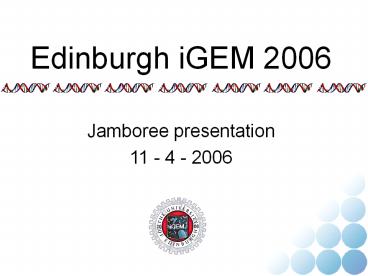Edinburgh iGEM 2006 - PowerPoint PPT Presentation
Title:
Edinburgh iGEM 2006
Description:
Current field technology: the ... Arsenic-sensing bacteria with a pH output. Very sensitive. pH requires an indicator, litmus paper or a simple electrode ... – PowerPoint PPT presentation
Number of Views:125
Avg rating:3.0/5.0
Title: Edinburgh iGEM 2006
1
Edinburgh iGEM 2006
- Jamboree presentation
- 11 - 4 - 2006
2
Intro to our team
- Team members
- Engineering
- Kim de Mora
- Bryony Davidson
- Jen Wilson
- Biology
- Judith Nicholson
- Farid Bizzari
- Jelena Aleksic
- Informatics
- Sreemati Lalgudi Seshasayee
- Patrick Cai
- Sergii Ivakhno
- Faculty
- Dr Chris French
- Dr Alistair Elfick
- Dr Hongwu Ma
- Laszlo Kozma-Bognar
www.Macteria.co.uk
3
- Why detect arsenic?
www.Macteria.co.uk
4
Bangladesh
Another cruel twist of fate
www.Macteria.co.uk
5
www.Macteria.co.uk
6
- 33-75 million people affected
www.Macteria.co.uk
7
?
www.Macteria.co.uk
8
- 100 million people worldwide
www.Macteria.co.uk
9
And not just in the developing world either
www.Macteria.co.uk
10
Arsenic detection method
- Current field technology the Gutzeit Method
- Expensive and unreliable (max sensitivity of 50
ppb 33 false negatives)
www.Macteria.co.uk
11
Our device
- Arsenic-sensing bacteria with a pH output
- Very sensitive
- pH requires an indicator, litmus paper or a
simple electrode - It is possible to engineer a quantitative
response - ureABC urease pH
- lacZ lactose fermentation pH
www.Macteria.co.uk
12
ArsR mechanism in E. coli
ArsR sensitive promoter
arsR gene
www.Macteria.co.uk
13
System gene circuit diagram
(-)
(-)
(-)
ParsR
? cI
ParsD
ureABC
arsD
lacZ
arsR
Responds to higher As (50 ppb)
Responds to low As (10 ppb)
Lambda cI / Lac I
As
As
pH
pH
3 step response 0 ppb As pH 9
10 ppb As pH 7
50 ppb As pH 4
www.Macteria.co.uk
14
? cI / LacI hybrid promoter detail
? cI binding site
ureABC
www.Macteria.co.uk
15
The model explained Urease operon
No. Name Equation
1 LacI production promoter3-gtpromoter3LacI
2 LacI binding to allolactose LacIallolactoseLacI-allolactose
3 LacI binding to promoter4 LacIpromoter4 LacI-promoter4
4 Urease production promoter4-gtpromoter4Urease
5 LacI degradation LacI-gtnull
6 Urease degradation Urease-gtnull
16
The model explained ?CI operon
No. Name Equation
7 ArsR production promoter2-gtpromoter2ArsR
8 ArsR binding to Arsenic ArsR2As(III)ArsR-2As(III)
9 ArsR binding to promoter2 2ArsRpromoter22ArsR-promoter2
10 LCI production promoter2-gtpromoter2LCI
11 LCI binding to promoter 4 LCIpromoter4LCI-promoter4
12 ArsR degradation ArsR-gtnull
13 LCI degradation LCI-gtnull
17
The model explained lacZ operon
No. Name Equation
14 ArsD production promoter1-gtpromoter1ArsD
15 ArsD binding to Arsenic ArsD2As(III)ArsD-2As(III)
16 lacZ production promoter1-gtpromoter1lacZ
17 ArsD binding to promoter1 2 ArsDpromoter12ArsD-promoter1
18 ArsD degradation ArsD-gtnull
19 lacZ degradation lacZ-gtnull
18
The model explained the whole system
19
Modelling result low arsenic
20
Modelling result high arsenic
21
Parameters sensitivity analysis
22
Parameter scanning
23
Building the biosensor
- To prove our concept and provide a starting point
for the larger device, we built a simple
construct - To test arsenic sensitivity and magnitude of pH
change (if any!)
Pars
ArsR
LacZ
www.Macteria.co.uk
24
Biobricks
- Putting new parts in the registry one of our
project aims - Created ArsR and Ars promoter parts from E. coli,
with B. subtilis for comparison - Also built new lacZ
- Hybrid promoter built and urease planned
(site-specific mutagenesis on urease)
www.Macteria.co.uk
25
Urease part ideas
- Secondary idea - 3D Structure Builder
- Links to biosensor model by using the urease part
- Tissue engineering, bioremediation, etc.
pH
Urea H2O? CO2 NH3
Calcium carbonate
www.Macteria.co.uk
26
Outcomes
- Result Simple construct built and ready to be
characterised with pH experiments - Several parts sequenced for registry
- Future Test hybrid promoter and urease device,
work towards full device
www.Macteria.co.uk
27
Characterization procedure
- Now we have the engineered constructs, we need to
test them - Aims
- to measure the scale of the pH response
- To test the sensitivity of the B. subtilis and E.
coli Arsenic promoters
www.Macteria.co.uk
28
Urease characterization
- The Wildtype urease contains 2 forbidden
restriction sites - The strain with the restriction sites removed
failed to change the pH (i.e. the mutagenesis
failed) - Only the wild type Urease operon produced a
change in pH
Note only 1 response from wildtype urease
www.Macteria.co.uk
29
E. coli biosensor characterization
- Only testing a yes/no response here
- arsR promoter begins to function after about 300
min - Difference of 0.6 pH units between control and
average readings
Note successful response at all concentrations
of arsenic
www.Macteria.co.uk
30
E. coli biosensor characterization
- Non-optimised growth medium conditions (response
could be faster) - Average overnight difference of 0.81 pH units
- Despite slower response, 5 ppb within sensitivity
of promoter - Can detect WHO guideline levels of Arsenic
(arsenate)
Note successful response at all concentrations
of arsenic
www.Macteria.co.uk
31
The desired end result
- Cheap, reliable, robust field test device
- Foolproof to operate and get accurate results
- Can be produced for less than 1 in mass volumes
www.Macteria.co.uk
32
The field test device
- A test tube could contain all the necessary
components Freeze dried bacteria, growth
medium, indicator powder, Ampicillin salt, etc
- These tubes could then be given to local
villagers to monitor their own water quality
themselves - A good alternative to the widely used Gutzeit
method
www.Macteria.co.uk
33
Conclusions
- Successfully designed and modelled complex device
- Proved a measurable pH response could be obtained
with As concentration to WHO standards - Successfully biobricked a variety of parts to
deposit in the registry - With further work, our device could potentially
help millions worldwide
www.Macteria.co.uk
34
We would like to thank our sponsors
- Funding assistance
- Sysbio 2.0 toolbox licenses
www.Macteria.co.uk
35
Questions?
Edinburgh Castle (on the only day this year it
wasnt raining)
www.Macteria.co.uk































